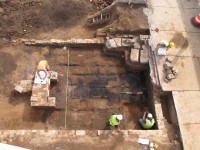 During an archaeological survey of a plot next to City Hall where a new courthouse will be built in Fredericksburg, Virginia, workers have discovered hundreds of artifacts and the remains of a row house that was burned during the Battle of Fredericksburg. It was a big surprise, as before the survey began researchers had searched the city records and the earliest evidence they’d found of a building on the site dated to 1886. Underneath the concrete slab foundation of the most recent structure on the site, the law offices of Thom Savage, they unearthed the cellar of what later research into the tax records indicated was the property of Fredericksburg businessman and pre-Civil War mayor Peter Goolrick. That concrete slab preserved the cellar, turning it into a time capsule of the Confederate victory.
During an archaeological survey of a plot next to City Hall where a new courthouse will be built in Fredericksburg, Virginia, workers have discovered hundreds of artifacts and the remains of a row house that was burned during the Battle of Fredericksburg. It was a big surprise, as before the survey began researchers had searched the city records and the earliest evidence they’d found of a building on the site dated to 1886. Underneath the concrete slab foundation of the most recent structure on the site, the law offices of Thom Savage, they unearthed the cellar of what later research into the tax records indicated was the property of Fredericksburg businessman and pre-Civil War mayor Peter Goolrick. That concrete slab preserved the cellar, turning it into a time capsule of the Confederate victory.
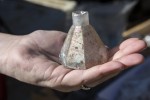 In all probability, the house was destroyed during the 1862 battle. It disappeared from the tax records in 1865, but it was already missing from pictures of the city taken in 1863. The remains of the sandstone cellar walls, a brick fireplace and carbonized heart-of-pine floorboards testify to the house’s demise by fire. The artifacts discovered within suggest the house played an interesting role in the battle fought between December 11th and December 15th of 1862. The team from archaeological contractors Cultural Resources, Inc. (CRI) found dozens of bullets, tobacco pipe bowls,
In all probability, the house was destroyed during the 1862 battle. It disappeared from the tax records in 1865, but it was already missing from pictures of the city taken in 1863. The remains of the sandstone cellar walls, a brick fireplace and carbonized heart-of-pine floorboards testify to the house’s demise by fire. The artifacts discovered within suggest the house played an interesting role in the battle fought between December 11th and December 15th of 1862. The team from archaeological contractors Cultural Resources, Inc. (CRI) found dozens of bullets, tobacco pipe bowls,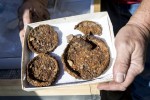 chinstrap buckles, pieces of a cartridge box and ration tins, glass inkwells, broken whiskey bottles and plates. Most significantly, they also found buttons and metal company insignia from uniforms, Union uniforms.
chinstrap buckles, pieces of a cartridge box and ration tins, glass inkwells, broken whiskey bottles and plates. Most significantly, they also found buttons and metal company insignia from uniforms, Union uniforms.
Historians believe the cellar was inhabited by Union troops during the Battle of Fredericksburg because its location was less exposed to Confederate shelling than some of the homes in the business district. According to CRI’s project archaeologist Taft Kiser, the insignia left in the cellar belonged to a regiment from Company C with the 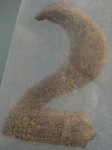 number “2” in its name. There are several possibilities. The hope is that a Union diarist who was part of that regiment might have left enough clues to their position to allow for a positive identification.
number “2” in its name. There are several possibilities. The hope is that a Union diarist who was part of that regiment might have left enough clues to their position to allow for a positive identification.
The timing of the discovery could not be more propitious. Fredericksburg has a number of events planned in memory of the 150th anniversary of the battle. The first has already kicked off: an exhibit at the Fredericksburg and Spotsylvania National Military Park of the favorite sword of General Ambrose Burnside, the Union officer who had replaced General George McClellan as commander of the Army of the Potomac on November 10th.
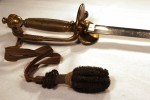 Burnside decided to move the army towards the Confederate capital of Richmond rather than continue on their southwestern route. The hope was to catch General Lee’s Army of Virginia off guard and bring the battle to the heart of the Confederacy. Unfortunately, the Union Army of the Potomac was an organizational disaster and even though large numbers of troops had reached the crossing point of the Rappahannock River opposite Fredericksburg by November 19th, the supplies to build the pontoon bridge to cross the river didn’t arrive until November 25th. By then, Lee was happily ensconced on the hills above the city.
Burnside decided to move the army towards the Confederate capital of Richmond rather than continue on their southwestern route. The hope was to catch General Lee’s Army of Virginia off guard and bring the battle to the heart of the Confederacy. Unfortunately, the Union Army of the Potomac was an organizational disaster and even though large numbers of troops had reached the crossing point of the Rappahannock River opposite Fredericksburg by November 19th, the supplies to build the pontoon bridge to cross the river didn’t arrive until November 25th. By then, Lee was happily ensconced on the hills above the city.
 Burnside, keenly aware of the political pressure on him to score a decisive confrontation and victory rather than pussyfoot around as McClellan had done after Antietam, chose to launch a frontal attack on Lee’s entrenched position. He chose poorly. After a day of intense Union cannon fire on the town, Union troops crossed the Rappahannock into Fredericksburg on the night of December 11th. They sacked the city but didn’t make a dent in Confederate lines. An attempt to breach them on December 13th resulted in the most lopsided slaughter of the Civil War, with eight Union soldiers dead for every one Confederate soldier. Under intense shelling from the high ground on the town perimeter, the Union troops in Fredericksburg hunkered down wherever they could find some shelter, including, apparently, the cellar of the building belonging to Peter Goolrick.
Burnside, keenly aware of the political pressure on him to score a decisive confrontation and victory rather than pussyfoot around as McClellan had done after Antietam, chose to launch a frontal attack on Lee’s entrenched position. He chose poorly. After a day of intense Union cannon fire on the town, Union troops crossed the Rappahannock into Fredericksburg on the night of December 11th. They sacked the city but didn’t make a dent in Confederate lines. An attempt to breach them on December 13th resulted in the most lopsided slaughter of the Civil War, with eight Union soldiers dead for every one Confederate soldier. Under intense shelling from the high ground on the town perimeter, the Union troops in Fredericksburg hunkered down wherever they could find some shelter, including, apparently, the cellar of the building belonging to Peter Goolrick.
The discovery will not impede construction of the courthouse, I’m sad to say. Over the next two weeks, the brick and sandstone foundations will be removed to make room for the foundations of the new building. Some of the stones of particular architectural interest — the ornamented Aquia stone steps, for example — will be preserved, as will the artifacts which will eventually be returned to the city for storage and display.
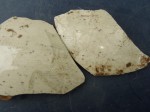 Some pre-Civil War remains have also been discovered on the site on the other side from the battle-scarred house. The team unearthed an 18th century well and a privy from the livery stables of George Gravatt. Pieces of a creamware chamber pot made in Staffordshire, England were especially charming because you can still clearly see the transfer print image of the Enterprise, a schooner that fought in the Barbary Wars of the early 19th century. Just 30 or so years after the end of the Revolutionary War, England was mass-producing consumer goods with patriotic images for the US market.
Some pre-Civil War remains have also been discovered on the site on the other side from the battle-scarred house. The team unearthed an 18th century well and a privy from the livery stables of George Gravatt. Pieces of a creamware chamber pot made in Staffordshire, England were especially charming because you can still clearly see the transfer print image of the Enterprise, a schooner that fought in the Barbary Wars of the early 19th century. Just 30 or so years after the end of the Revolutionary War, England was mass-producing consumer goods with patriotic images for the US market.
For more events commemorating the 150th anniversary of the Battle of Fredericksburg, see this National Parks Service schedule.